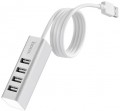USB version
This paragraph refers to the USB connection interface. Refers to both the classic USB A and the type C port. The main difference between the interface versions is the bandwidth — speed.
—
USB 2.0. The outdated version 2.0 provides data transfer rates up to 480 Mbps. Found only in USB A ports.
—
USB 3.2 gen1. The previous names of the USB 3.1 gen1 and USB 3.0 standard (they know how to confuse). Unlike 2.0, this version provides 10 times the maximum speed (4.8 Gbps), as well as higher power supply, which allows you to connect power-hungry devices and extensive splitters.
—
USB 3.2 gen2. Further improvement of the USB 3.2 gen1 standard (and, as is customary, the previous name USB 3.1 gen1 and simply USB 3.1, which was renamed more than once), made it possible to achieve a maximum speed of 10 Gbps and even higher power for external devices.
USB А
The number of USB inputs located on the case of the card reader or hub (see "Type"). The number of USB ports that you will have at your disposal after connecting the device depends on this parameter. "Pure" card readers and combined models, usually, have 1,
2 and even
3 USB inputs, while hubs have
4 or more ports.
USB A version
This paragraph refers to the USB connector interface. The main difference between the interface versions is speed. It is worth noting that the speed of the input connector does not yet indicate the overall throughput, since the simultaneous connection of
flash drives,
phones, memory cards slows down data transfer, which anyway is limited by the interface for connecting the device itself to a PC or
laptop(item "Connection interface").
- USB 2.0. The outdated version 2.0 provides data transfer rates up to 480 Mbps. Found only in USB A ports.
- USB 3.2 gen1. The previous names of the USB 3.1 gen1 and USB 3.0 standard (they know how to confuse). This version provides 10 times the maximum speed (4.8Gbps) as well as higher power supply, which allows you to connect power-hungry devices and large splitters.
- USB 3.2 gen2. Further improvement of the USB 3.2 gen1 standard (and, as is customary, the previous name USB 3.1 gen1 and simply USB 3.1, which was renamed more than once), made it possible to achieve a maximum speed of 10 Gbps and even higher power for external devices.
Switch
The presence of a switch that allows you to turn off the power supply to the USB ports. This function can be implemented either by one
common switch for all ports at once, or by personal
buttons for each port.
External power supply
External USB devices require power to work, which is supplied to them through the same USB port. However, the power of such power supply is relatively low (especially in version 2.0 ports, see "Connection"), and if several external devices are connected to one port of the computer through a hub, a situation may arise when the power is not enough for their operation.
Connecting an external power supply to the hub allows you to avoid such situations: the hub receives additional power from the network and supplies power of the appropriate power to each of its inputs.
Another option for using devices with this function is charging portable equipment via USB: some models can work as stand-alone chargers that do not require connection to a computer.
Removable USB cable
The ability to disconnect the cable from the device through which it is connected to the USB port of the computer (see "Connection"). This gives a certain convenience during transportation — a
removable cable is somewhat easier to lay than a non-removable cable, you can carry it separately, etc. In addition, it becomes possible to replace the cable — for example, if the regular cable is not long enough, or if it is damaged.
Cable length
The length of the cable supplied with the device. Mostly relevant for models with a non-removable cable that cannot be replaced.
Activity indicator
Light indicator, indicating that data is currently being exchanged between the memory card and the computer to which the card reader is connected. This allows you to avoid disconnecting the card reader during operation, which is fraught not only with data loss, but even damage to the device.
Material
The main material used for the body of the device.
— Plastic. Plastic is light, cheap, quite practical, incl. has good strength properties. In addition, it allows you to create cases of complex shape and almost any color.
—
Metal. As a rule, aluminium-based alloys are used for metal cases. Such cases are much stronger than plastic ones, and also have a stylish appearance. On the other hand, in terms of impact protection, this material has no advantages over plastic, but it costs more, and it can weigh much more.

